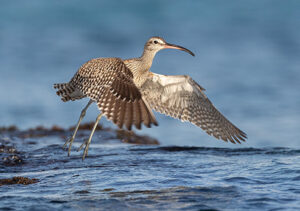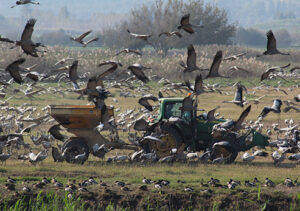HULA VALLEY, Israel (Press Release) — After a long process of being developed as an international birdwatching park, KKL-JNF has initiated a unique project for the benefit of land site visitors, professional and amateur birdwatchers worldwide, an extensive project consisting of network of HD live cameras.

The project includes installation of electric infrastructure, laying a few km of optic fibers and wireless systems, and placing a system of eight online super zoom cameras controlled via a control center and real-time broadcast screens at our visitor’s center – from eight different spots on lake Hula’s grounds.
The Hula Valley is an agricultural region in northern Israel with abundant fresh water, which used to be Lake Hula, prior to its draining. It is a major stopover for birds migrating along the Syrian-African Rift Valley between Africa, Europe, and Asia.
In each wondering season, in the autumn and in the spring, over a billion birds passes through the Hula Valley (500 million during spring and 500 million during autumn). So far About 300 different bird species were spotted in the valley. Thousands of them chose to stay even during the winter season, while the others come in the spring and summer. The lake is used by wandering birds as a resting spot and as a source for food.
Avishay Mizrachi, Director of Communications and Technology Department at KKL – JNF and a birdwatcher himself, said, “We have been working on this sophisticated and international project for over three years now. Installing 10 super zoom night vision 4k flir ptz cameras with around 7 km fiber optic infrastructure. It is a dream come true for Effi Naim the Hula valley area manager. Effi, who is familiar with the Hula landscape for decades now, has specially pointed the locations for the cameras according to the best spots of interest. For professionals’ birdwatchers, Agmon Hula is one of the most respected places in the world, and now we can allow birdwatchers from all over the world watch what is happening in the field, via live broadcast. We are in the beginning of the migration season and in about two or three weeks, birds will start arriving. We expect tens of thousands of visitors per day on the cameras link site.”

The Live from the Hula Lake project consists of eight different cameras:
Cranes Birdwatching Spot: A live feed from a spot watching the landing site of tens of thousands of cranes that visit the Hula Lake during the wandering season. Through the feed you can see the cranes eating, performing their famous mating dance, and more.
The lagoon: A live feed camera provides a view of the lagoon that it rich with birds and growth. Different bird species – Cormorant, Ceryle Rudis, and Alcedinidae among others – can be seen.
Western Shore – South: An excellent birdwatching spot across the lake at the water level on the western side.
Buffalos: A live-feed camera placed in front of the living area of the great buffalo herd at the Hula Lake. Dozens of buffaloes can be seen, alongside many bird species.
The tower: A live-feed camera placed at the top of the old watchtower, providing a panoramic view of the lake.
Western Shore – North: An interesting water-level observation spot, which provides a review of the many water birds and their activity.
Pelican Birdwatching Spot: This live-feed camera overlooks the habitat of the pelicans, who arrive during the wandering season with more guests. The camera also provides a view of the bee-eaters wall, which is full of birds during the spring and early summer seasons.
Cranes Gathering Spot During the Wandering Season
*
Preceding provided by KKL-JNF